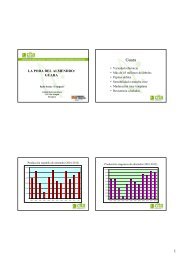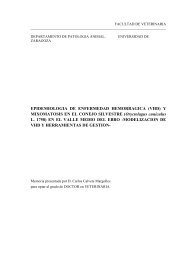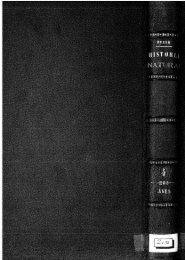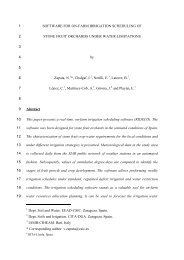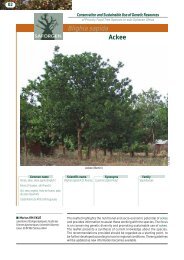1 A Recursive Dynamic Computable General Equilibrium Model For ...
1 A Recursive Dynamic Computable General Equilibrium Model For ...
1 A Recursive Dynamic Computable General Equilibrium Model For ...
You also want an ePaper? Increase the reach of your titles
YUMPU automatically turns print PDFs into web optimized ePapers that Google loves.
the crops for which data on ‘gross’ potential land and yields is available on the cited web<br />
page is presented in Table 1.<br />
To proceed with the estimation of the land supply, first the yields data are sorted in<br />
descending order (with the corresponding potentially suitable areas), and second, the<br />
ascending area is accumulated. Then, following Tabeau et al., (2006) the variable ‘land<br />
price’ is defined as the inverse of the potential yield (1/yield). Furthermore, for each<br />
observation, a relative yield is calculated, dividing each potential yield by the maximum<br />
attainable by the region. In this way, the potential relative yield lies between 0 and 1, while<br />
the corresponding relative rental rate or land price, will have a minimum of 1. This scaling<br />
process helps to infer the relative suitability of each country for each crop, while from an<br />
econometrical point of view, scaling contributes to accelerate the convergence to a<br />
solution.<br />
Thus, the relationship between the observations on accumulated land area and<br />
relative price follows an upward sloping curve (land supply). To improve the fit of the<br />
estimated supply parameters (b, C and ) to the observed data points, 15 a Maximum<br />
Likelihood non linear regression method is employed. A key advantage of Maximum<br />
Likelihood is that it can be applied to a wide variety of models (e.g. models with binomial,<br />
multinomial, or censored dependent variable). Irrespective of the numerical algorithm used<br />
to find a solution to a non-linear model, the maximum likelihood estimator has good<br />
asymptotic (for large samples) properties: it is consistent (when the sample size tends to<br />
infinity, the expected value of the estimator approaches its true value and its variance tends<br />
to zero); asymptotically efficient (the variance of the asymptotic distribution of the ML<br />
estimator is smaller than the asymptotic variance of any other consistent estimator); and<br />
estimates of the (asymptotic) variances of the estimators as a by-product of the estimation<br />
process (Pindyck and Rubinfeld, 1998). <strong>For</strong> regression models (with a continuous<br />
dependent variable), if we make the assumption that the error terms are normally<br />
distributed, the maximum likelihood estimators coincide with the various least squares<br />
estimators. Therefore, non-linear least squares could also be used. In practice, however,<br />
results from both models could differ, but mainly because of the numerical algorithms<br />
implemented for each method and by each econometrical package.<br />
The econometric model to estimate then becomes:<br />
15 The smaller is the value b, the more inelastic is the land supply curve. The smaller is C, the more elastic is<br />
the land supply curve. The smaller is ρ, the more inelastic is the land supply curve.<br />
23



